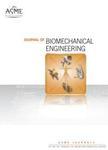版权所有:内蒙古大学图书馆 技术提供:维普资讯• 智图
内蒙古自治区呼和浩特市赛罕区大学西街235号 邮编: 010021

作者机构:Columbia Univ Dept Biomed Engn New York NY 10027 USA Columbia Univ Dept Radiol 351 Engn TerraceMail Code 8904 New York NY 10027 USA
出 版 物:《JOURNAL OF BIOMECHANICAL ENGINEERING-TRANSACTIONS OF THE ASME》 (生物机械工程学杂志;美国机械工程师学会汇刊)
年 卷 期:2021年第143卷第3期
页 面:031005页
核心收录:
学科分类:0831[工学-生物医学工程(可授工学、理学、医学学位)] 0710[理学-生物学] 1001[医学-基础医学(可授医学、理学学位)] 10[医学]
基 金:US National Institutes of Health (NIH) [R01HL135734 R01 GM083925]
主 题:fluid-structure interaction pulse wave imaging biomechanical modeling pulse wave velocity finite element modeling atherosclerosis
摘 要:Pulse wave imaging (PWI) is an ultrasound-based method that allows spatiotemporal mapping of the arterial pulse wave propagation, from which the local pulse wave velocity (PWV) can be derived. Recent reports indicate that PWI can help the assessment of atherosclerotic plaque composition and mechanical properties. However, the effect of the atherosclerotic plaque s geometry and mechanics on the arterial wall distension and local PWV remains unclear. In this study, we investigated the accuracy of a finite element (FE) fluid-structure interaction (FSI) approach to predict the velocity of a pulse wave propagating through a stenotic artery with an asymmetrical plaque, as quantified with PWI method. Experiments were designed to compare FE-FSI modeling of the pulse wave propagation through a stenotic artery against PWI obtained with manufactured phantom arteries made of polyvinyl alcohol (PVA) material. FSI-generated spatiotemporal maps were used to estimate PWV at the plaque region and compared it to the experimental results. Velocity of the pulse wave propagation and magnitude of the wall distension were correctly predicted with the FE analysis. In addition, findings indicate that a plaque with a high degree of stenosis (70%) attenuates the propagation of the pulse pressure wave. Results of this study support the validity of the FE-FSI methods to investigate the effect of arterial wall structural and mechanical properties on the pulse wave propagation. This modeling method can help to guide the optimization of PWI to characterize plaque properties and substantiate clinical findings.